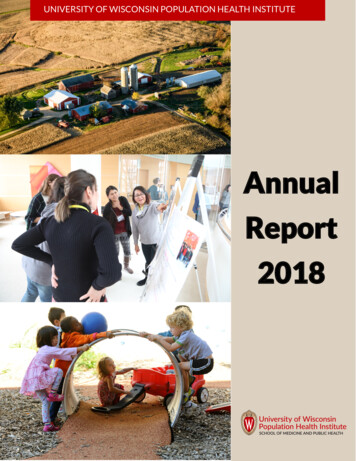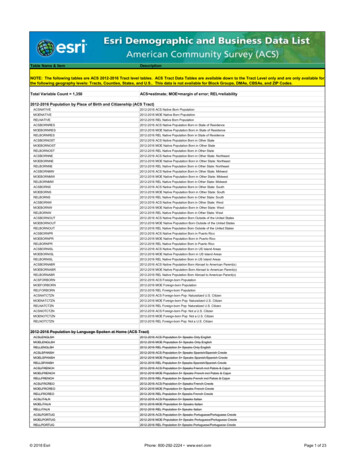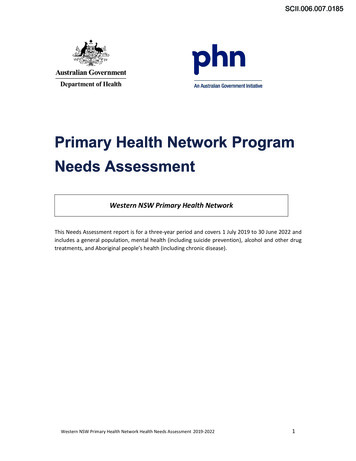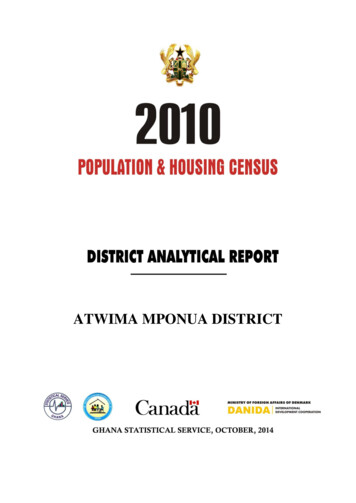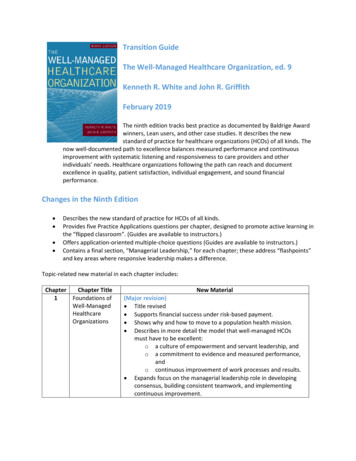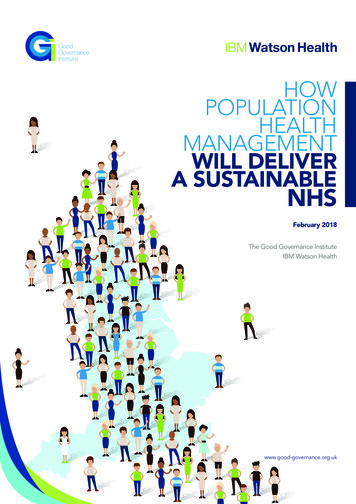
Transcription
NTWILL DELIVERA SUSTAINABLENHSFebruary 2018The Good Governance InstituteIBM Watson Healthwww.good-governance.org.uk1
GoodGovernanceInstitute2
How population health management will deliver a sustainable NHSTitle:How population health management will deliver a sustainable NHSDate:February 2018Authors:Andrew Corbett-Nolan, Chief Executive, GGIDivia Mattoo, Consultant, GGILaura Tantum, Project Manager: Knowledge and Research, GGIReviewed by:Darren Grayson, Director of Delivery, GGIDesigned by:Emiliano Rattin, Creative Manager, GGIGood Governance InstituteThis report is part of a growing series of reports developed by the Good Governance Institute (GGI) that consider issues contributing to the bettergovernance of healthcare organisations. GGI is an independent organisation working to improve governance through both direct work with individualboards and governing bodies, and by promoting better practice through broader, national programmes and studies. We run board developmentprogrammes, undertake governance reviews and support organisations develop towards authorisation.Other recent GGI reports and board development tools have considered integrated governance, governance between organisations, scrutiny andassurance, system transformation and new models of care, enablers in the delivery of system transformation, the future of the NHS, and of course goodgovernance.GGI is committed to develop and promote the Good Governance Body of KnowledgePublished by GGI Development and Research LLP, LondonISBN: 978-1-907610-45-5 2018 Good Governance InstituteGood Governance Institute, The Black Church, St Mary’s Place, Dublin 7, D07 P4AX, Republic of Irelandinfo@good-governance.org.ukFollow the Good Governance Institute on Twitter: nce.org.uk3
GoodGovernanceInstituteGGI exists to help create a fairer, better world. Our part in this is to support those who run theorganisations that will affect how humanity uses resources, cares for the sick, educates future generations,develops our professionals, creates wealth, nurtures sporting excellence, inspires through the arts,communicates the news, ensures all have decent homes, transports people and goods, administersjustice and the law, designs and introduces new technologies, produces and sells the food we eat – inshort, all aspects of being human.We work to make sure that organisations are run by the most talented, skilled and ethical leaderspossible and work to fair systems that consider all, use evidence, are guided by ethics and therebytake the best decisions. Good governance of all organisations, from the smallest charity to the greatestpublic institution, benefits society as a whole. It enables organisations to play their part in building asustainable, better future for all.4
Each day, leaders, advocates, and influencers in health make powerful progress toward a healthier futurefor individuals, families, communities, and work places. However, in an industry riddled with complexityand uncertainty, these professionals still face significant headwinds on their path to progress.IBM Watson Health provides customers with the technology and expertise they need to power thrivingorganizations, support vibrant communities, and solve health challenges for people everywhere. Itis supported by the proven innovation of IBM, the dynamic intelligence of Watson, and its collectiveexpertise in and commitment to improving the health industry.Providing unmatched visibility and connectivity across the industry, Watson Health helps unlocknontraditional data sets—social, physiological, genomic, economic, and more— so that professionals canuncover critical insights into the determinants and implications of modern and holistic health.Equipped with these insights, professionals are poised to take action -- creating new capabilities andways of working that help them keep pace with the changing landscape and: Pursue remarkable outcomes. Leverage innovative capabilities in analytics, workflows, andinsights to drive better health economics and productivity, so they can more quickly andeffectively advance toward life-changing results. Establish essential connections. Easily tap into, and take advantage of health ecosystems byconnecting to the knowledge, skills, and capabilities needed most. Accelerate discovery. Quickly identify the optimal path forward by utilizing advanced tools andintuitive solutions that expedite problem solving. Achieve heightened confidence. Decide and take action with increased certainty by uncoveringunique sets of robust and actionable insights.Watson Health offers best-in-class capabilities in five key areas across the health landscape, including: Oncology and Genomics: Working to help clients transform cancer care for patients andproviders. Value-based Care: Working to help clients control costs and address quality by managingpopulations, engaging with consumers, and making more confident decisions. Life Sciences: Working to help clients advance more rapid and efficient delivery of targeted andeffective therapies. Imaging: Working to help clients expand the role of medical imaging for better patient care. Government: Working to help clients improve the value of health and human services, lowercosts, and have a meaningful impact on people’s lives.Watson Health is working to empower everyday heroes to transform health—creating a bettertoday and a brighter tomorrow for patients, communities, and populations.Are you ready to join us and start your transformation?5
Foreword and acknowledgementsPart of our mission at the Good Governance Institute (GGI) is to help boards have insight into the keystrategic issues of the day. We have previously developed reports and assurance tools for boards ontelehealthcare, long-term conditions and new care models. Population health management has clearlybecome one such strategic issue and this is reflected in NHS England’s latest planning guidance for2018/19.IBM Watson Health is a recognised global leader on population health management. In November 2017GGI was approached by IBM Watson Health with a grant to develop an independent white paper forNHS boards on this topic. We have developed our thinking very much in collaboration with colleaguesin the NHS, using an advisory board and around 35 interviews with those informed on the potential ofpopulation health management, and those connected to NHS boards who have no particular interest inthe subject but who represent a typical range of NHS board members and their advisers. The paper wasfurther developed at a round table of NHS, local authority and policy leaders held on 30 January 2018.IBM Watson Health has also brought their wealth of insight and experience to the report.Our research was also underpinned by an in-depth literature review on population health and populationhealth management. Several case studies are cited in the report to illustrate how population healthmanagement is being applied.GGI would like to thank IBM Watson Health who came to us with the idea for this report, as well asall those who so generously contributed their time to take part in the advisory group, interviews anddiscussions which have informed our report, including all those who attended our 30th January roundtable and offered helpful ideas and debate.Andrew Corbett-NolanChief ExecutiveGood Governance Institute6
Table of Contents1.Introduction1.11.22.Developing a population health management system2.12.22.32.43.Setting the sceneExamples of early innovationOutlook for NHS boardsConclusions4.14.25.Examples of innovation from the USAnalysis and infrastructure for population health managementA framework for infrastructureDeveloping system maturityPopulation health management in the NHS3.13.23.34.The case for changePopulation health managementRecommendationsHow population health will deliver a sustainable NHSAppendix5.15.25.35.45.5Introducing population health management maturity matrixKey assurance questions for NHS boardsList of contributorsReference listFurther reading7
1.Introduction1.1The case for changeIn common with all western healthcare systems, the UK’s NHS has significant challenges to address.The success of public health and healthcare systems over the last half a century in terms of extendinglifespans and supporting a large portion of the population to live many years with chronic illness,together with the pipeline of new treatments and therapies available, is putting enormous pressure onthe system to remain sustainable and able to deliver accessible, high quality healthcare at low cost. Ithas been predicted that 2018/19 will be the most financially difficult year for the NHS in the currentparliament, as well as one of the most challenging in NHS history, with funding for the Department ofHealth set to grow by only 0.4% in real terms. Meanwhile, social care remains in significant crisis, facing afunding gap of 2.5 billion by 2019/20.1Policy makers believe that the inherited NHS model, designed to treat people episodically, often inhospital and when they become sick, is not sustainable in its current form. In its place, an agenda ofintegrated care and prevention is being seen as the way forward, as set out in NHS England’s Five YearForward View (5YFV). Presenting the vision of a sustainable NHS which makes most efficient use ofscarce resources while delivering more co-ordinated care to healthier communities, this key nationalpolicy paper outlines why the NHS needs to change to close the triple gap of health and well-being,care and quality, and funding and efficiency by introducing new models of integrated care.2 Perhapsmost significant of this move towards integration are the Sustainability and Transformation Partnerships(STPs) that build on the collaborative work that began under the NHS Shared Planning Guidance for2016/17 – 2020/21, to support the implementation of the 5YFV. Delivered through 44 geographical‘footprints’ in England, STPs provide a vehicle to support the full integration of health and social care.The driving force behind STPs is the need to create a system capable of optimising health and well-beingby aligning multiple players across health, social, and other key sectors.3 NHS England has announcedambitions for STPs to gradually evolve into Accountable Care Systems (ACSs) and later Accountable CareOrganisations (ACOs) within several years.4 NHS England has developed thinking for new models ofcare, for example by developing Multispecialty Community Providers (MCPs) and Primary and Acute CareSystems (PACS), the first of which have been launched with vanguard status. In the most recent guidanceof February 2018, NHS England sought to further accelerate this policy, giving ACOs and ACSs theumbrella term of Integrated Care Systems (ICSs)5.Integral to the creation of STPs is a focus on prevention, keeping people well for longer, treating them inthe community, and reducing admissions into acute hospitals. Doing this successfully will depend upona strategy that is capable of aligning multiple players in common purpose and working towards welldefined goals to create communities that foster health-promoting behaviours and broaden health care topromote health outside of the medical system.61.2Population health managementPopulation health is the health outcomes of a group of individuals, including the distribution of suchoutcomes within the group.7 The shift happening in the UK, as well as numerous other countries aroundthe globe, is one away from health systems designed to better manage chronic disease care towardssystems designed to enhance population health. Population health management, or PHM, aims tooptimise the health of populations over individual life spans and across generations.8 Population healthmanagement is the nexus that brings together an understanding of population need (public health)through big-data, patient engagement and healthcare delivery to embrace the triple aim of experienceof care, the health of populations and cost-savings (see figure 1).8
Figure 1 - Dimension of population health managementBIG DATA ANDPOPULATIONANALYSISPREVENTIONANDPUBLIC HEALTHDIGITALHEALTHAND MANAGEMENTAND SELF CAREOF LTCSPATIENTENGAGEMENTANDEMPOWERMENTAt this time of great increase in healthcare needs, itself driven by the success of healthcare in turningmany previously fatal conditions into long-term conditions (LTCs) and continuously increasing lifeexpectancies, the NHS stands at the edge of an ocean of possibilities presented by new technology.These new technologies hold the triple promise of developing effective ways of risk-driven targeting ofhealthcare interventions to those who need it most and at the moment when it will add the most value tothe patient’s life; the involvement of the patient in an informed and authentic way in their own care andcontinuously improving healthcare services themselves. The ability to look simultaneously at morbiditiesacross a given population, and at the same time identify the status and needs of an individual within thatpopulation, opens up the possibility of being able to manage the increasing care needs of citizens in away that is simply not possible within the current NHS-provision model.Population health management in the years ahead will go beyond the analysis of data to pick upon group and individual risk in a way that triggers an intervention. New technologies will be able toassimilate research data and, together with an understanding of an individual patient’s somatic status, beable to (in mere seconds) develop a risk-assessed, tailored treatment plan and care pathway. In contrast,it is estimated that to stay up to date with research articles would take a physician 627.5 hours a monthof reading.9 Already, algorithms are beginning to outperform radiologists on diagnosing pneumonia.10Telehealthcare, including the patient’s own impressions of their healthcare status (for example, painlevels felt or confidence levels in their own well-being), is becoming both more sophisticated and lessexpensive. We are near to a time when robots will be routinely used to perform surgery with greatprecision and speed. Together with population health management, the use of technology in the comingyears will change opportunities for patients and the way in which we routinely experience interventionsin ill-health, in just the same way as it will change all other aspects of how humans live on this planet.11The key issue is how those responsible for healthcare services today will ensure the speediest and mosteffective introduction of new possibilities for the maximum benefit of NHS patients.9
2.Developing a population health management system2.1Examples of innovation from the United StatesThe United States has a long history of accountable care dating back to the 1980s and 1990s. Thedevelopment of ACOs has been accelerating in recent years following earlier managed care initiativesin which medical groups and integrated networks of providers worked to deliver care under risk-based,largely capitated contracts. However, these early initiatives focused mainly on cutting cost, rather thanimproving quality.12 Since then, following the example of pioneering ACOs such as Kaiser Permanente,ACOs in the US have been employing population health methods as a central facet in achieving theInstitute for Healthcare Improvement’s ‘triple aim’ of improving the patient’s experience and improvinghealth outcomes for patients, while decreasing the cost of care (see figure 2). In the US, recent thinkinghas focused on the ‘quadruple aim’ adding the goal of improving the work life of health care providersto the original three aims13. In the NHS context, the triple gap discussed in the NHS FYFV encouragedthinking to focus on reducing health inequalities as the fourth or ‘quadruple aim’. Whatever thedifference, there has been consensus around the focus on the triple gap and triple aim in both countries.Figure 2 - The Triple AimBETTER CARE ANDPATIENT NGOFHEALTHCAREPROVIDERSIn the US, the focus on a holistic approach to healthcare is not new. To achieve their vision of thequadruple aim, healthcare organisations realised that they needed to expand beyond their own four wallsand the more traditional approach of episodic care.14 Organisations involved in population health couldtherefore include, in addition to healthcare providers, care management services, providers of ancillaryservices, educational services, and providers related to wider well-being, for example communicationdevices, supplies for new mothers, and healthy food.15 The emphasis is on improving all aspects of thepatient’s health and well-being, and the health of the community as a whole.In the case studies below, we explore how two healthcare providers in the US have been working toimprove the health of the populations they serve. It is worth noting that the current tendency to lookto the US for lessons in progressing system maturity has led to some concern in the UK because of thevery different contexts in which the US and UK healthcare systems are based. There are clear differencesbetween the socialised system of the NHS and the dominance of private healthcare provision in theUS. Therefore, lessons from the US cannot be neatly or identically transferred into the UK context.Nevertheless, the US examples, with their greater maturity, do provide both extremely helpful insight aswell as mature management tools that are useful as NHS organisations move forward with implementingpopulation health management.10
Case study: Mercy Health, Ohio, US16Mercy Health is a healthcare provider based in Cincinnati, Ohio which serves communities throughout Ohioand Kentucky, through more than 450 health facilities, including 23 hospitals. Mercy Health delivers a rangeof services from maternity to senior care, and its net operating revenue in 2015 was 4.3 billion. MercyHealth Select, LLC is an expanded network that supplements the organisation’s 563 directly employedprimary care providers (PCPs) with a further 89 ‘affiliated’ PCPs. In 2016, the care of nearly 150,000 patientsin at-risk contracts was managed by Mercy Health Select.To ensure that it is delivering a value-based patient care model, Mercy Health Select is proactive inidentifying and intervening with patients whose health is at risk. However, not all of the affiliated PHPsthrough which the provider operates use the same electronic health record platform, which has createdchallenges in sharing information about at-risk patients among different facilities. The decision wastherefore made to implement an AI system (the IBM Explorys Platform from IBM Watson Health) to facilitateits improved delivery of value-based patient care, using the platform to quickly gather any pertinent claimsand clinical information about its patients. It then uses analytics to quickly identify and prioritise high-risk,high cost patients. If, for example, a patient who was not previously high risk has had a stroke, clinicians donot have to wait for up to several months to find that out and are able to follow up much more quickly.The use of data analytics supported by AI has delivered tangible improvements in performance for MercyHealth Select. Enabling care managers to quickly identify and prioritise patients whose risk scores haveincreased allows more rapid intervention for these patients, reducing the risk of episodic admissions tohospital in the case that avoidable illness eventually develops. Meanwhile, Mercy Health Select receivedan ACO score of 97.1% from the Center for Medicare and Medicaid Services in 2015, which is some 5.7%higher than the average among MSSPs. This secures a higher portion of shared savings for Mercy HealthSelect, and in turn a better standard of care for at-risk patients.Case study: Orlando Health, Florida, US17Orlando Health is one of the state of Florida’s most comprehensive private, not-for-profit healthcarenetworks. It serves nearly 2 million residents of Central Florida through 8 hospitals and 1,780 beds, aswell as around 4,500 international visitors nationally. Orlando Health is also Central Florida’s fifth-largestemployer with more than 14,000 employees, including 500 employed physicians.In order to manage the challenges facing the health sector, Orlando Health realised early that it must actdifferently and early on planned to adopt a population health management solution. However, havingreviewed the availability of data to help make this transition to both population health management andvalue-based billing, Orlando Health had two options: either to manually aggregate the records for itspopulation across various EHR systems being used, which would be impractical, or to rely on claims datawhich could be out of date.As an alternative measure, Orlando Health implemented the IBM Watson Health population healthmanagement platform, which automated as much of the process as possible, including acting as a pseudohealth information exchange (HIE) to aggregate data from all the EHR, and automating functions such asbuilding registries, identifying care gaps, engaging patients to close the gaps in care, and running qualityperformance reports. Then, in order to encourage patients to seek recommended care, patients who wereidentified as meeting certain criteria were engaged with through a platform which automated outreach andcontact with patients.Within one year, the introduction of population health management had demonstrated significant results: Increased the number of its diabetic patients who received HbA1c tests by 7%Increased preventative mammogram screening by 10%Increased colorectal cancer screening by 9%Increased the number of patients overall who closed care gaps by 22%Generated 6.6 million in shared savingsThese improvements are expected to be further enhanced as the programme continues to move forward.11
2.2Analysis and infrastructure for population health managementThere are many lessons for the NHS that can be derived from the US experience. Examples taken fromthe US model have been organised around the following key enablers of population health management:Figure 3 - Enablers for NA data-driven approach to understanding the needs of individuals and cohorts of people is key in orderfor population health management to be successful. Necessary infrastructure needs to be developed,and in-depth analysis of the population undertaken using big data. Both intervention and preventionthen become possible resulting in long-term system transformation that creates savings which can bere-invested back into supporting the infrastructure for PHM.The approach to the analysis of a given population using insights from big data revolves around fouraspects as illustrated below:i.ii.iii.iv.understanding population needsopportunity analysispredictive power of interventionfinancial impact assessment.Figure 4 - PHM analysis using big SESSMENT1213OPPORTUNITYANALYSIS2PREDICTIVEPOWER OFINTERVENTION
Each element is comprised of the following steps and would require reliable and interconnected datapools:1.Understand the needs of the population:a.b.c.d.2.Opportunity analysis to improve the quality of care:a.3.Find duplication in healthcare costs, any gaps in care, triple fail events (instances where allthree aspects of the triple aim fail to be achieved) and address themPredictive power of intervention:a.4.Joint Strategic Needs Assessment (JSNA), undertaken in partnership between the NHSand the local authorityIndividual patient timeline creationPatient pathways in real lifeUnwarranted variations (underuse / overuse of services)Impactibility modelling: identify those who will and will not respond to preventiveinterventions before interveningFinancial impact assessment:a.Assessing financial viability in the long-term and capturing multi-sector financial impactsoutside of healthcare costs. This enables a single budget for a broad scope of healthcareservicesAnalyses in more advanced population health management systems have supported population dataanalysis through harnessing big data techniques. Once all the healthcare data available has beenaggregated, methods such as risk stratification are harnessed in order to identify individuals and subpopulations most likely to benefit from targeted interventions. Data can be filtered to sort patients not onlyby their health characteristics, but also by functional abilities, housing situation, employment or educationsituation, among others. Solutions can then be implemented that meet the needs of individual patientsfacilitating person-centred care.18Joint Strategic Needs Assessment (JSNA): a definition19JSNA is an exercise undertaken in collaboration by local authorities and NHS Clinical CommissioningGroups (CCGs), in order to understand and agree the needs of the people that make up the area theyserve. The JSNA was introduced in order to create stronger partnerships between communities, localgovernment and the NHS, and to ensure that commissioning is shaped to address local needs. Led byhealth and well-being boards, JSNAs explore the current and future needs and assets of the area, includingthe wider determinants of health. The results should then be used in the development of a health and wellbeing strategy for the area.Interventions are therefore evidence-based and co-designed with patients and clinicians, as well as thevarious organisations involved in the delivery of population health management.202.3A framework for infrastructureIn order to conduct this kind of analysis, having the necessary infrastructure is key. Based on theirexperience of supporting the implementation of population health management in the US, IBM WatsonHealth has developed a framework for infrastructure based around four key components: Governance and decision-makingTechnical preparednessClinical transformationFunding and incentivesBelow, we explore in more detail each of these components, and consider how the NHS will need to bereshaped in order to facilitate effective population health management.13
Governance and decision-makingThe NHS is currently operating in the environment created by the Health and Social Care Act 2012, whichencouraged competition between organisations and championed the commissioner/provider split . With thedevelopment of STPs, health and social care organisations are being asked to collaborate more closely, and todo so in a system un-reformed by primary legislation. This creates a host of practical and important governancechallenges, as local leaders are asked to work collectively on their STP while still being held to account andregulated as individual organisations. Nevertheless, system leaders need to work together to develop sharedrisk arrangements, ensure appropriate organisational representation, engage stakeholders, and to considerfunding and regulatory requirements all while working openly. Success in achieving this will largely depend ona change in culture, reflecting the shift away from competition in the NHS.21 In introducing population healthmanagement, system leaders will need to be prepared to go beyond this in enabling its success. Indeed, theFebruary 2018 planning guidance from NHS England specifically identifies population health managementas a key sustainable improvement and seeks local leaderships to embrace this approach. Importantly, localauthorities will need to be as engaged in the STP process as their NHS partners, which anecdotal evidencesuggests has not always been the case so far. It is local authorities who employ the vast majority of public healthspecialists who will have a central role in the development of population health management. Governance anddecision-making arrangements will need to involve Health and Well-being Boards sufficiently, which shouldcontinue to provide leadership in prevention and proactive health and well-being. As a marker of success, awell-defined governance model and strategy will align partner organisations and their stakeholders on a sharedvision of population health management and patient engagement.Technical preparednessWhile the development of both artificial intelligence (AI) and digital health is quickly progressing in thehealthcare industry, numerous reports have found that healthcare in the UK is behind other industries withregards to its embracing of the opportunities technology can bring.22,23 Nevertheless, there is a hugeamount of healthcare data available to providers. It was estimated in 2014 that the volume of globalhealthcare data is 153 exabytes. To put this into perspective, one exabyte equals one billion gigabytes,and five exabytes is equal to all the words ever spoken by humans. Furthermore, this figure is continuouslygrowing, with the projected growth rate in 2014 being 48% annually. If this is accurate, the number wouldgrow to 2,314 exabytes by 2020.24It has been established that effective population health management will require comprehensive dataanalysis. However, this level of data realistically cannot be processed and turned into intelligence by humanminds. Therefore, a robust digital infrastructure will be necessary to ensure that the benefits populationhealth management can bring are fully realised.25 Embracing ‘big data’ techniques has the power toincrease the efficiency of population health management as well augmenting the range of data thatclinicians and other care providers can use in determining solutions and interventions. Furthermore, asmachine learning and cognitive analytics read and evaluate unstructured data through natural languageprocessing, risk stratification and patient profiling will become even ric
Population health management has clearly become one such strategic issue and this is reflected in NHS England's latest planning guidance for 2018/19. IBM Watson Health is a recognised global leader on population health management. In November 2017 GGI was approached by IBM Watson Health with a grant to develop an independent white paper for
